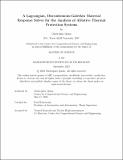| dc.description.abstract | Thermal protection systems (TPS) play a vital role in safeguarding aerospace vehicles from the intense aerodynamic heating encountered during hypersonic flight. One category of TPS materials manages extreme heat through pyrolysis, a process in which the elevated temperatures trigger an endothermic reaction that decomposes the material into char and gases, and through thermochemical ablation, in which char and pyrolysis gases blow away from the surface. Their use is common in high-velocity hypersonic missions through dense atmospheres, in contrast to other materials such as reusable TPS, which are often used in lower heat flux scenarios. Analysis of ablative TPS materials is challenging due to their complex material response which involves a combination of thermal, chemical, and mechanical phenomena.
A major concern in hypersonic vehicle design is the catastrophic failure of the TPS. It is necessary to anticipate scenarios in which excessive ablation, inelastic deformation, or fracturing of the TPS occurs. A successful TPS design should account for these failure modes while balancing concerns about cost, weight, and vehicle performance.
Computational modeling has emerged as an important tool in TPS design, and in predicting the behavior of TPS materials including failure. Existing codes are capable of modeling the thermo-chemical response of ablative TPS and predicting some modes of failure, but they are often limited in their ability to model mechanical deformation and damage.
This thesis proposes a new computational framework for modeling the thermo-chemomechanical behavior of ablative TPS materials to address this gap. The modeling approach is based on a Lagrangian, Discontinuous-Galerkin finite element formulation of the coupled multiphysics problem, which includes models of finite elastic and inelastic deformation as well as damage, pyrolysis reactions, heat, and mass transfer. The numerical solution employs a semi-implicit time integration scheme for the nonlinear heat and mass transfer problems, while the solid mechanics is addressed using dynamic relaxation. Importantly, a mesh recession algorithm is implemented to explicitly account for changes in geometry due to material ablation. A staggered iteration scheme is used to couple the multiphysics problem.
Several numerical examples demonstrating the correctness and versatility of the proposed method are presented. These include verification against several analytical solutions to the heat equation and benchmark problems utilized in the ablation modeling community. The mesh recession algorithm is also verified through a series of numerical tests known as patch tests. Finally, a demonstration of an arc-jet experiment of phenolic-impregnated carbon ablator (PICA) is presented to illustrate the computational framework’s ability to model thermo-chemically induced deformation, stresses, and surface recession in pyrolyzing TPS materials. | |
